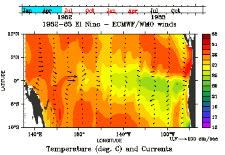PMEL Programs and Plans
Accomplishments in FY 99 and Plans for FY 00

Figure. Hindcast of 1982-1983 El Niño.
Thermal Modeling Analysis Project
Accomplishments in FY 99
- El Niño global ocean surface anomaly composite, and robust
features, published. There are many common features of the last
ten events. The most variability occurs during the Onset and
Decay phases of the events, but they have many similarities once
they get started. No statistically significant case can be made
that recent events differ from other post-WWII events. (Harrison
and Larkin, Rev. of Geophys)
- US statistically significant seasonal weather anomalies (and
extreme anomalies) associated with El Niño events described and
compared with the anomalies of the 97-98 El Niño. Although there
are statistically significant anomalies over 90% of the US in
either temperature or precip in one or more of Autumn, Winter and
Spring, only a few regions in a few seasons have anomalies really
strongly linked to El Niño. These regions, seasons, and
anomalies are described. (Harrison and Larkin, GRLet)
- A new mechanism for the end-phase of El Niño events, which
depends on the seasonal shift of warmest SST south of the equator
and the observed SST-zonal wind anomaly connection, has been
described. Simple model experiments suggest that the effect may
be more important than delayed oscillator reflected waves in
creating the central and eastern Pacific thermocline shallowing
that appears to precede the end of El Niño events. (Harrison and
Vecchi, GRLet)
- A strong association between anomalies of NPac storm tracks,
blocking events and high-zonal index periods and the SSTA over
the core of the PDO region has been identified. NCEP/NCAR
Reanalysis turbulent heat fluxes suggest that flux anomalies are
substantial and that they are of a sign so as to try to remove
the SSTA. (Bond and Harrison (GRLet)
- The SST changes following Westerly Wind Events have been
evaluated. There is cold tongue warming following Type W and C
WWEs, if the ocean was normal or cooler than normal initially.
And the ocean remains warmer than normal following them, if it
was warmer than normal initially. In the absence of WWEs the
ocean SST returns toward climatology. Because the mechanisms for
these types of behavior have been described via model studies of
the equatorial Pacific, it is suggested that WWEs are a key
element of atmospheric variability for the onset and maintenance
of El Niño conditions. (Harrison and Vecchi, Vecchi and
Harrison, J.Climate)
- The statistically significant ocean surface anomalies during
the Cold Phases of ENSO have been described and their robustness
evaluated. While there are many similarities between Cold and
Warm phases in the tropical Pacific the extra-tropical Pacific
anomalies show many differences. There are stronger and
longer-lived anomalies in the North Pacific, the tropical Indian
and the tropical Atlantic oceans during Cold events than during
Warm events. (Larkin and Harrison, J. Climate).
Plans for FY 00
- Continue study of atmospheric subseasonal variability and its
effects on ENSO. Composite the ocean surface expression of the
MJO during periods when NINO3 SSTA is cooler than normal, normal
and warmer than normal. Evaluate the OLR signatures of WWEs and
contrast with those of the MJO. Composite the cold tongue SST
changes following WWEs, according to whether or not the WWE was
part of an MJO. Examine the effects of MJO forcing on the
tropical Indian and Atlantic oceans.
- Compare the ENSO Cold and Warm event composites, in the
context of EOF and regression "S-I" modal patterns, simple models
of SST-wind anomaly relationships, and simple coupled models of
ENSO.
- Examine the utility of regression modes for Pacific decadal
variability of SST and wind and wind speed. Examine the US
seasonal weather associations relative to a North Pacific SSTA
index
that is in the core PDO region.
- Work with NCEP and NRL/MRY to try to improve the impact of
ocean surface wind observations on operational surface wind
products.
- Work with NCEP, OSU and FNMOC toward a new ocean data
assimilation system for NCEP, using the MOM-4 model.
|

